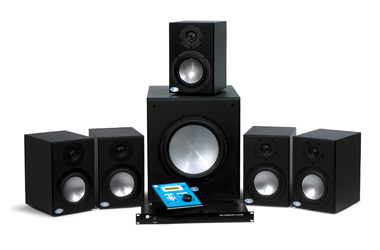Evolution & The Art of Speaker Design
May 17, 2008

This article was also published in the October 2001 edition of Pro Sound News. You can download a PDF copy by following this link to the Blue Sky website (130KB Adobe Acrobat PDF).
Through the ages, science and art have always been closely linked. These days people have forgotten how much individual artistic talent goes into truly magnificently engineered products. An example of a product that requires a considerable amount of technical and artistic talent is an accurate studio monitor. This article will show how a new technology, known as BOO®, can bring artistic vision and ideal acoustic performance to the marketplace more quickly and take out much of the guesswork.
Designing a modern loudspeaker involves many factors, including: Output requirements, room acoustics, directivity requirements, psychoacoustics (how people perceive sound), and design philosophy. Design philosophy can also be interpreted as the artistic vision for a product. Artistic vision / design philosophy is typically made up of the factors, that a company or engineer has discovered through research and experience, which make a speaker sound “goodâ€.  For Blue Sky International these factors usually include such things as smooth on & off axis frequency response, flat on axis response, a wide listening window, and meeting a certain output requirement.
Unfortunately the process of getting from a set of components and the necessary cabinet, to a “good†sounding speaker, is hit or miss at best. Prior to starting the design of a loudspeaker, a manufacturer will typically take the performance data of the drivers, design a box and then start the process of modeling a crossover & EQ. Typically a software program is used that takes into account some of the driver parameters and the box parameters and then creates a “rough†equalization and crossover design. The problem with this simulated crossover network is that the software rarely considers on & off axis frequency response, electrical response and the many ways to get to the same point. Additionally, the real world measurement data rarely correlates with the predicted acoustic response and always requires many tweaks. These tweaks can take a huge amount of time and are akin to a painter having to try hundreds of mixtures of paint, then paint the entire canvas and then start over again because it doesn’t look right. This process is wasteful and time consuming, plus it distracts the engineer from getting to the “artistic vision†and acoustic performance criteria that are important to him or her.
To deal with this problem, Audio Design Labs created a software program called BOO™ which is an acronym for Binary Organic Optimization. BOO™ combines a high-powered electro-acoustic simulator with an optimizer based on a genetic mathematical algorithm called differential evolution. Genetic algorithms are simplified mathematical models of the biological processes that organisms like bacteria use to mutate and evolve. You can apply the same strategy to optimize electro/acoustical circuits. In this case, the speaker is the organism, the crossover the DNA, and the components are the genes. The program is given a target response curve, which is the goal of the evolution process. The program then creates a population of organisms (speakers) with genes (component values). Then parents are selected out of the gene pool and combined with a randomized vector (mutation) to create children. The children that match the target better than their parents survive (evolve). The ones that are inferior to their parents die (don’t survive). Thereby, a new population of organisms is created and the process repeats until the process can evolve no more (the crossover is the best it will be).
BOO™ has now created an optimal crossover design, which takes into account the many complex characteristics of the drivers and the enclosure. Multiple parameters can now be evaluated, including the electrical signal that will be sent to each driver, the on & off axis frequency response and how close the system performance will get to the design goal. If the system doesn’t perform as desired, changes can be made (new tweeter, woofer, different box, new crossover topology, etc.) and BOO™ can re-run the evolutionary process until the system is performing as desired.
At this point it is time to build a real world crossover and speaker system, measure the performance of the product, compare it to the predicted results and move on to the next step of the design process, listening tests.
It must be said, that it is extremely rare for BOO’s predicted performance to be off by any great degree (if any). In fact, real world measurement errors have been discovered using BOO’s predictions.
BOO™ is a proprietary technology first used in the development of Blue Sky International’s Sky System One, made up of the SAT 6.5 and SUB 12. As a side note, no embryos were destroyed in the development of BOO™ but we may have lost a mouse or two.
To find out more about Blue Sky’s complete line of studio monitoring systems, follow these links to Product Reviews and Blue Sky News on the Blue Sky website. If you have any questions, or would like to find out what ADL can do for you, please don’t hesitate to contact us.
This article was also published in the October 2001 edition of Pro Sound News. You can download a PDF copy by following this link to the Blue Sky website (130KB Adobe Acrobat PDF).



